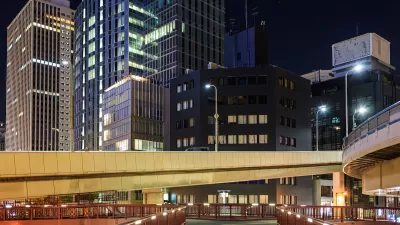A formula for the ideal office-to-housing candidate.

On the heels of a New York Times story by Emily Badger and Larry Buchanan explaining the complicated puzzles involved in converting office buildings to housing, Nate Berg, writing in Fast Company, describes the formula for an office building that can be successfully converted: “Typically, they’re mid-rise, modestly sized structures built before World War II, with at least two sides fronting open areas or streets in neighborhoods near, but not directly in, the city’s dense financial center.”
Architect and structural engineer Charles F. Bloszies analyzed San Francisco office buildings and found dozens of potential conversions that “make sense both economically and structurally.” The analysis follows the principle highlighted by Badger and Buchanan: that a residential building requires access to light and air for all units, features common in the pre-war buildings described above, those found in what Bloszies describes as the ‘Goldilocks zone.’ Unlike modern high-rise offices with sealed windows and little light exposure, “Bloszies’s analysis found that there are many structures that don’t have those issues, mostly four- or five-story prewar buildings that have operable windows and nestle into neighborhoods instead of towering above them.”
Berg adds that “The kind of analysis Bloszies undertook could be done with public information in nearly any city. Savvy developers, project-ready architects, or even proactive city planners could quickly identify office buildings in this Goldilocks zone and either start pursuing projects or fast-track the zoning changes that could help them take shape.” A future as housing may not be in the cards for all former office buildings, but some could also serve as data centers, logistics facilities, or other non-residential uses.
FULL STORY: Too big? Too small? No, these office buildings are just right for housing

Planetizen Federal Action Tracker
A weekly monitor of how Trump’s orders and actions are impacting planners and planning in America.

Congressman Proposes Bill to Rename DC Metro “Trump Train”
The Make Autorail Great Again Act would withhold federal funding to the system until the Washington Metropolitan Area Transit Authority (WMATA), rebrands as the Washington Metropolitan Authority for Greater Access (WMAGA).

The Simple Legislative Tool Transforming Vacant Downtowns
In California, Michigan and Georgia, an easy win is bringing dollars — and delight — back to city centers.

The States Losing Rural Delivery Rooms at an Alarming Pace
In some states, as few as 9% of rural hospitals still deliver babies. As a result, rising pre-term births, no adequate pre-term care and "harrowing" close calls are a growing reality.

The Small South Asian Republic Going all in on EVs
Thanks to one simple policy change less than five years ago, 65% of new cars in this Himalayan country are now electric.

DC Backpedals on Bike Lane Protection, Swaps Barriers for Paint
Citing aesthetic concerns, the city is removing the concrete barriers and flexposts that once separated Arizona Avenue cyclists from motor vehicles.
Urban Design for Planners 1: Software Tools
This six-course series explores essential urban design concepts using open source software and equips planners with the tools they need to participate fully in the urban design process.
Planning for Universal Design
Learn the tools for implementing Universal Design in planning regulations.
Smith Gee Studio
City of Charlotte
City of Camden Redevelopment Agency
City of Astoria
Transportation Research & Education Center (TREC) at Portland State University
US High Speed Rail Association
City of Camden Redevelopment Agency
Municipality of Princeton (NJ)





























